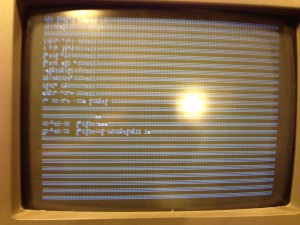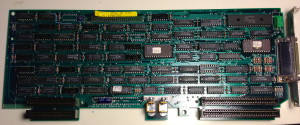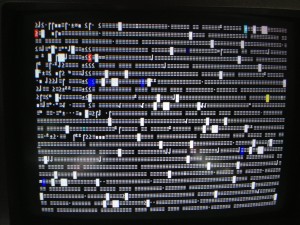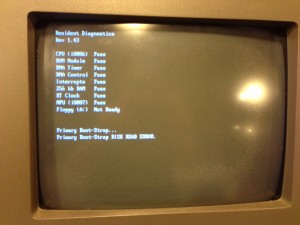I was at the computer recycler a couple of years ago and this machine caught my eye. It was a very different looking machine compared to others of it’s era. The case has a sidecar for the hard drive unit which makes it look even more odd. When I bought it, the monitor and keyboard cables had been cut in two. Instead of reaching around with a screwdriver to properly remove the cords, someone just decided to slice the cables.
I fixed that at least a year ago. I popped open the monitor and meticulously sorted out all of the wires needed. You might think that would be fairly trivial but this monitor uses a DB25 connector. I didn’t know it was actually a color CGA (sort of) monitor until I popped it open to do the sorting. After a couple hours of sorting, I finally got it all wired up. I plugged it in and saw this:
At that point it became obvious why the computer was discarded. I got busy and stuck the machine aside. Recently, in a fit of cleaning, I stumbled on the machine again (literally). I figured it was time to do something with this box or toss it.
I fired it up to the same old familiar screen. Next, I pulled ALL of the cards. I wanted to make sure those weren’t somehow acting poorly. This machine is VERY unique. The video card is also the backplane. The motherboard lives on the bottom of the case and is connected to the expansion slots via the video card. When I get the machine fully running, I’ll post more pictures that will better explain this.
Once I had room to maneuver, I hooked up my logic probe and logic pulser and actually managed to locate a schematic for this beast. I started out just probing around randomly until I find some interesting signals. Occasionally I would hit a chip with the pulser. Usually the effect was just some noise in the video signal but then I started getting closer to the right section. I found a chip to probe where on of the pins would pulse every time the flashing line on the screen changed. AHA! Must be close now.
I looked some more at the schematic and found the character ROM where the default font is stored. I probed around on it and decided that it must be bad since it’s the only thing I can’t replace… so I thought. I took a look through my junk box and found the original CGA video card that came with my PCXT. Low and behold it had the exact same EPROM on it. I figured that was random luck though and there would be no way it would work even if it was the same chip.
I decided to swap it and by some form of magic, it did in fact work. The problem still remained exactly the same though. I decided this was good though and moved on to other areas. I decided to eavesdrop on the four TMS4416-15NL DRAM chips. I figured that the signals in and out of them should all be similar so I compared the signals. I found that one of the chips had a couple of dead data out lines. Since all of the address lines appeared to be doing what I would expect, I determined that this one chip must be the problem. I also decided to hit a couple of the lines with my pulser.
This reaction proved that I was on the right track. Once again, I went searching on the IBM CGA adapter and found an exact match for the ram chip I needed. Thankfully, the ram on the IBM board is socketed. Unfortunately this is not the case with the Olivetti board. I had one socket that fit in my parts box though so I popped that onto the Olivetti board and popped the chip into it. After reassembling enough of the machine to test the board, I was eventually rewarded with this:
This is probably not the end of the problems with this machine. Far from it in fact but it’s an interesting machine in good condition so it’s well worth the effort and the digital trouble shooting skills I’ve gained from this experience are well worth the money I paid for the machine in the first place.





